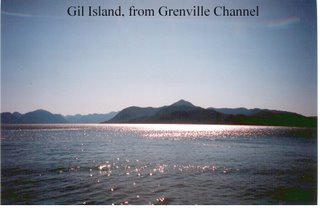Gil Island Notebook

Hi, folks! Here I am, on the southern end of Gil Island, where Hecate Strait and Douglas Channel meet on BC's North Coast. This is the home of the humpbacks, and I am staying with my friends Hermann and Janie from Cetacealab.
Last Saturday we spotted two humpbacks while out on the water in appropriately-named Whale Channel. Yesterday we got as far as Squally Channel, on a beautiful, sunny calm afternoon. No whales were present, but the scenery was spectacular, with the steep sloping evergreen forests rising out of the translucent, deep blue sea. Magical! Our seaborne outing was followed by a hike up a boggy incline in back of Janie and Hermann's cabin, with stunning views from the summit over to the channel between Ashdown Island and Princess Royal Island, home of the Kermode, or 'Spirit' Bear, so named because of its whitish colour.
What impresses me most about this region, which is basically Caamano Sound, is its vastness and relatively-pristine state. When you are out on the water in Whale Channel, for instance, all you see is water, interrupted by islands and the hills and mountains that adorn them. There is next to no evidence of human presence on the horizon, in any direction.
This seemingly idyllic place is about as isolated as it gets. Sure, King Pacific Lodge is only a fifteen-minute boat ride away, and the Gitgat community of Hartley Bay perhaps an hour by boat. However, these two sites are themselves far from civilisation. And right here on Gil Island, which is about the size of Salt Spring Island in the Gulf Islands, our only neighbours are the whales ( humpbacks and killer whales, mainly ), the sea lions, the eagles, the spawning pink salmon, the wolves, the ravens and the black bears.
As I write this I have the headphones on, listening in on at least one humpback singing nearby the hydrophone at Money Point, near Hartley Bay. Hermann and Janie, who are both away this evening, leaving me in charge of the acoustics lab, tell me that it is quite unusual for the humpbacks to sing during their feeding sojourn in this part of the woods. Normally this kind of behaviour occurs only during the winter months, at their Hawaiian mating grounds. It is thought that the male humpback ( and it is only the male that sings ) could be getting in a bit of practice before the long journey south.
Janie and Hermann have been researching the distribution and habits of whales for the past four years. I will be filing further instalments of my experience up here in the days to come.

0 Comments:
Post a Comment
<< Home